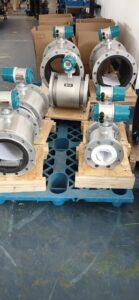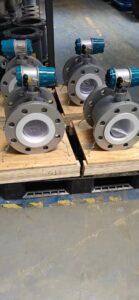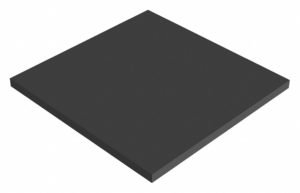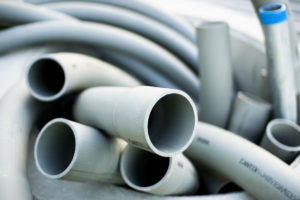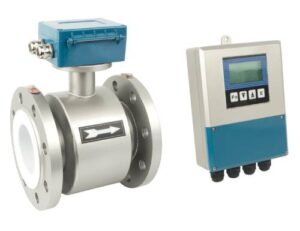One of the basic conditions for the operation of an electromagnetic flowmeter is that the normal current in the inner wall of the measuring tube is zero except for the electrode.
To meet this condition, the simplest method is to line the inner wall and flange the end face of the conductive metal measuring tube with insulating linings.
In layman’s terms, the purpose of using an insulating lining is to prevent the induced signal voltage from being short-circuited by the metal pipe. It can be seen that the insulating lining plays a very important role in the application of electromagnetic flowmeters. Therefore, in the history of the development of electromagnetic flowmeters, the application of lining materials and the continuous improvement of lining manufacturing technology have also been accompanied.
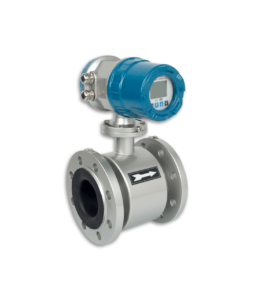
There are many types of fluids in the measured conductive medium, and their physical and chemical properties are not the same. It is impossible to use an insulating material lining to meet the physical and chemical properties of all applications of electromagnetic flowmeters.
These requirements are manifested in the requirements of the medium’s temperature resistance, thermal shock, high pressure, negative pressure, abrasion, corrosion, adhesion, and adhesion of the lining.
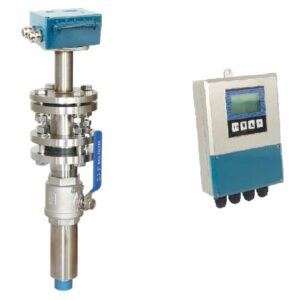
Conversely, it is precise because the measuring tube has various lining materials that can adapt to the physical and chemical characteristics of the fluid medium, which makes the application range of the electromagnetic flowmeter wider.
The measuring tube is lined with an insulating material lining, which of course brings the complexity of the manufacturing process and various processing difficulties, because the physical and chemical properties of various lining materials are different, and their processing methods are also different. Therefore, lining processing has become one of the most difficult technical keys in sensor manufacturing.
According to the principle of the basic requirement that the normal current of the pipe wall is zero, it was envisaged that the metal measuring pipe wall and the measured fluid medium should be kept in an equipotential state so that no insulating lining is required. This idea has been successfully prototyped.
However, the millivolt level (even microvolt level) of the electromagnetic flowmeter’s flow signal voltage is based on the zero potential of the fluid medium, and there is a common mode interference far greater than the amplitude of the flow signal, so it is difficult to use the metal pipe Find a stable reference potential with zero potential.
At the same time, this method of equal potential between the inner wall of the metal tube and the fluid is to amplify the power of the flow signal and apply a larger current to the metal measuring tube to make the fluid potential follow the change of the flow signal potential on the electrode, and always maintain The metal measuring tube and the fluid medium are in an equipotential state, which is technically difficult. Therefore, up to now, electromagnetic flowmeters with metal measuring tubes that are not lined have not been commercialized yet.
At present, the lining materials used for measuring tubes at home and abroad include polytetrafluoroethylene, rubber polyvinyl chloride, polyurethane rubber, industrial ceramics, and other materials. In the past, glass fiber reinforced plastic, enamel lining, PVDF, etc. were also used, but now they are rarely used. The main performance characteristics and processing methods of these lining materials are briefly introduced below.
1.Fluoroplastic
Among the fluoroplastics used as electromagnetic flowmeters, there are usually PTFE, FEP, E-TEE, and PFA. See Table 5-5 for their molecular composition, performance, and processing. Among these fluoroplastics, polytetrafluoroethylene (PTFE) has the best chemical stability, but PTFE and stainless steel measuring tubes are difficult to bond together.
Although the bonding process between PTFE and acid-resistant steel measuring tubes has been broken, some of the products’ PTFE villages are still in close contact with acid-resistant steel measuring tubes.
Therefore, it is necessary to pay attention to the temperature and pressure changes of the fluid during use. The negative pressure and the drastic temperature changes caused by thermal shock will easily cause the lining to be separated from the measuring tube, peel off, and break, which will cause the electrode seal to leak and cause the output of the instrument to be unstable or even damaged.
The other three fluoroplastics are slightly inferior to PTFE in corrosion resistance, but they can all be injection molded or molded, and adopt measures such as adding stainless steel wire mesh or stainless steel measuring tube inner wall and flange end face to make dovetail grooves, and injection molded fluoroplastics are more integrated with it. Strong, can better solve the problem of fluid thermal shock and negative pressure
2. Rubber is one of the most commonly used lining materials for electromagnetic flowmeters. It is used in measuring water, sewage, and normal temperature fluids with weak acids and weak bases, and its usage is relatively large. Commonly used rubber types include natural rubber, neoprene, nitrile rubber, etc.
3. Polyurethane rubber Polyurethane has excellent abrasion resistance, equivalent to more than 10 times the abrasion resistance of natural rubber.
It is generally used to measure the sensor lining of water-containing mud, coal water slurry, and mineral slurry, and the temperature is usually below 70 kilometers. Polyurethane rubber lining usually has casting molding, centrifugal casting molding, and processing and molding through the vulcanization process.
4. PVC pipe Rigid polyvinyl chloride pipe (PVC pipe) is a kind of engineering plastic profile, no need to be lined with insulating material, it is used directly as a measuring pipe. For example, the measuring tube, diversion nozzle and simulation sensor of the submersible electromagnetic flowmeter are all made of rigid polyvinyl chloride tubes.
Some general electromagnetic flowmeter measuring tubes for low temperature and low-pressure fluid measurement can also be made of hard polyvinyl chloride pipes. Rigid PVC has the advantages of good chemical resistance, flame resistance, self-extinguishing, abrasion resistance, high strength, and good electrical insulation. Its shortcomings are poor thermal stability and different degrees of degradation caused by heat.
The operating temperature is -20~+70C. The sensor can be made of hard polyurethane pipes and plates, using plastic welding processing methods.
5. Industrial ceramics In the 1980s, industrial ceramics represented by high-purity aluminum oxide materials began to be used in the measuring tubes of electromagnetic flowmeters.
Industrial ceramics are made by sintering with 99.6% to 99.9% Al2O3. See Appendix F for the corrosion resistance of industrial ceramics.
Industrial ceramic linings have higher rigidity and mechanical strength than fluoroplastics, rubber, and polyurethane rubber linings, and have good heat resistance, wear resistance, and corrosion resistance and their electrical insulation properties are also very good.
There is almost no deformation under high temperature and high pressure, so the size is stable. The thermal shock destructive test proves that the advanced sintering process can ensure a wide range of thermal shock resistance of the industrial ceramic measuring tube. The hardness of industrial ceramics is so high that it is difficult to reprocess the sintered measuring tube by cutting process.
Its wear resistance is more than 10 times higher than that of polyurethane rubber. The corrosion resistance of industrial ceramics depends on the type and purity of the ceramics.
For example, the same is Al2O3, the purity is 99.7% and 99.9%, as shown in Table 3-3, the corrosion resistance of different purity is quite different.
The measuring tube made of industrial ceramics can be made of cermet (Pt-Al2O3) mixed with platinum powder and alumina to form an electrode structure without sealing parts so that no electrode leakage occurs, and there is no phenomenon such as liquid retention and penetration. The electrode part and the inner wall of the measuring tube have the same size and the same smooth surface.
The friction coefficient when the slurry fluid flows through is small, the low-frequency polarization voltage that appears is very low, and the meter output is stable. The improvement of this material and process is very important to solve the reliability and corrosion resistance of electromagnetic flow, and it is very effective.
| Different purity alumina and corrosion resistance | ||
| Corrosive environment
Purity |
20% HCL,95℃ | 20% NaOH,95℃ |
| 99.7%Al2O3 | 0.075mm/year | 0.112mm/year |
| 99.9%Al2O3 | 0.047mm/year | 0.084mm/year |
The sintering temperature of high-purity alumina ceramics is very high, about 1800°C, which has exceeded the melting point of metal acid-resistant steel. Therefore, the time control and process methods of heating, heat preservation, and cooling of the sintering process directly affect the quality of the product.
In short, industrial ceramics is an ideal village material.
However, due to the complex production process and high technical difficulty, the domestic industrial ceramic electromagnetic flowmeter still needs to be developed, and foreign countries can only achieve diameter measuring tubes below DN200.

